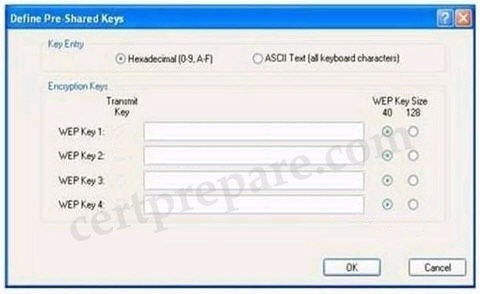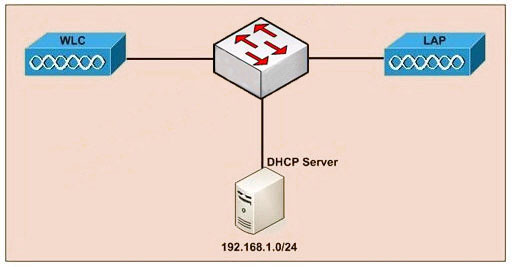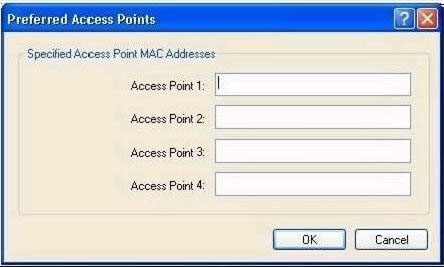Question 1:
Which two Lightweight Access Point Protocol (LWAPP) statements are true? (Choose two)
A. Layer 3 LWAPP is a UDP / IP frame that requires a Cisco Aironet AP to obtain an IP address using DHCP.
B. Data traffic is encapsulated in UDP packets with a source port of 1024 and a destination port of 12223.
C. Data traffic is encapsulated in TCP packets with a source port of 1024 and destination port of 12223.
D. Control traffic is encapsulated in UDP packets with a source port of 1024 and a destination port of 12223.
Answer: A D
Question 2:
Which statement about the Lightweight Access Point Protocol (LWAPP) is true?
A – LWAPP encrypts control traffic between the AP and the controller.
B – LWAPP encrypts user traffic with a x.509 certificate using AES-CCMP.
C – LWAPP encrypts both control traffic and user data.
D – When set to Layer 3, LWAPP uses a proprietary protocol to communicate with the Cisco Aironet APs.
Answer: A
Question 3:
LWAPP is meant to be a network protocol for access points that also provides for centralized management. Which issue or set of issues does the Lightweight Access Point Protocol (LWAPP) address?
A. provides security by blocking communication between access points and wireless clients.
B. reduction of processing in wireless controllers.
C. distributed approach to authentication, encryption, and policy enforcement.
D. access point discovery, information exchange, and configuration.
Answer: D
Question 4:
If you are a network technician, which two WLAN client utility statements do you think are true? (Choose two)
A. In a Windows XP environment, a client adapter can only be configured and managed with the Microsoft Wireless Configuration Manager.
B. The Microsoft Wireless Configuration Manager can be configured to display the Aironet System Tray Utility (ASTU) icon in the Windows system tray.
C. The Cisco Aironet Desktop Utility (ADU) and the Microsoft Wireless Configuration Manager can both be enabled at the same time to setup WLAN client cards.
D. The Aironet Desktop Utility (ADU) can be used to enable or disable the adapter radio and to configure LEAP authentication with dynamic WEP.
Answer: B D
Question 5:
In order to enhance worker productivity, a Cisco wireless network has been implemented at all locations. Which three WLAN statements are true? (Choose three)
A. A WLAN client that is operating in half-duplex mode will delay all clients in that WLAN.
B. Ad hoc mode allows mobile clients to connect directly without an intermediate AP.
C. A lightweight AP receives control and configuration from a WLAN controller to which it is associated.
D. WLANs are designed to share the medium and can easily handle an increased demand of channel contention.
Answer: A B C
Question 6:
Currently in draft status at the IETF, LWAPP outlines a standard protocol to be used by switches or routers to control a group of IEEE 802.11 wireless LAN access points and make their deployment much simpler than is possible today. Which statement about the Lightweight Access Point Protocol (LWAPP) protocol is true?
A. The processing of 802.11 data and management protocols and access point capabilities is distributed between a lightweight access point and a centralized WLAN controller.
B. LWAPP authenticates all access points in the subnet and establishes a secure communication channel with each of them.
C. LWAPP advertises its WDS capability and participates in electing the best WDS device for the wireless LAN.
D. LWAPP aggregates radio management forward information and sends it to a wireless LAN solution engine.
Answer: A
Question 7:
Which set of statements describes the correct order and process of a wireless client associating with a wireless access point?
A.
1. Client sends probe request.
2. Access point sends probe response.
3. Client initiates association.
4. Access point accepts association.
5. Access point adds client MAC address to association table.
B.
1. Client sends probe request.
2. Access point sends probe response.
3. Access point initiates association.
4. Client accepts association.
5. Access point adds client MAC address to association table.
C.
1. Access point sends probe request .
2. Client sends probe response.
3. Client initiates association.
4. Access point accepts association.
5. Client adds access point MAC address to association table.
D.
1. Client sends probe request.
2. Access point sends probe response.
3. Client initiates association.
4. Access point accepts association.
5. Client adds access point MAC address to association table.
Answer: A
Question 8:
You are a network technician, study the exhibit carefully. What should be taken into consideration when using the Cisco Aironet Desktop Utility (ADU) to configure the static WEP keys on the wireless client adapter?
 A – Before the client adapter WEP key is generated, all wireless infrastructure devices (such as access points, servers, etc.) must be properly configured for LEAP authentication.
A – Before the client adapter WEP key is generated, all wireless infrastructure devices (such as access points, servers, etc.) must be properly configured for LEAP authentication.
B – The client adapter WEP key should be generated by the AP and forwarded to the client adapter before the client adapter can establish communication with the wireless network.
C – In infrastructure mode the client adapter WEP key must match the WEP key used by the access point. In ad hoc mode all client WEP keys within the wireless network must match each other.
D – The client adapter WEP key should be generated by the authentication server and forwarded to the client adapter before the client adapter can establish communication with the wireless network.
Answer: C
Question 9:
You work as a network technician ,please study the exhibit carefully. When it attempts to register to a wireless LAN controller (WLC), what type of message is transmitted by the lightweight access point (LAP)?
 A – The LAP will send both Layer 2 and Layer 3 Lightweight Access Point Protocol (LWAPP) mode discovery request messages at the same time.
A – The LAP will send both Layer 2 and Layer 3 Lightweight Access Point Protocol (LWAPP) mode discovery request messages at the same time.
B – The LAP will send Layer 2 Lightweight Access Point Protocol (LWAPP) mode discovery request messages only.
C – The LAP will send Layer 3 Lightweight Access Point Protocol (LWAPP) mode discovery request messages only.
D – The LAP will send Layer 2 Lightweight Access Point Protocol (LWAPP) mode discovery request messages. If the attempt fails, the LAP will try Layer 3 LWAPP WLC discovery.
Answer: D
Question 10:
Please study the exhibit carefully. Which one is true about the configuration of access point MAC addresses on the wireless client?
 A – If the wireless client is out of range of the specified access point or points it will not associate with other access points.
A – If the wireless client is out of range of the specified access point or points it will not associate with other access points.
B – Each access point MAC address that is specified must have a separate SSID configured on the GENERAL configuration tab.
C – Each access point MAC address that is specified must have the same SSID configured on the GENERAL configuration tab.
D – If the wireless client is out of range of the specified access point or points it can associate with other access points.
Answer: D
Question 11
A campus infrastructure supports wireless clients via Cisco Aironet AG Series 1230,1240, and 1250 access points. With DNS and DHCP configured, the 1230 and 1240 access points appear to boot and operate normally. However, the 1250 access points do not seem to operate correctly.
What is the most likely cause of this problem?
A. DHCP with option 150
B. DHCP with option 43
C. PoE
D. DNS
E. Switch port does not support gigabit speeds
Answer: C
Which two Lightweight Access Point Protocol (LWAPP) statements are true? (Choose two)
A. Layer 3 LWAPP is a UDP / IP frame that requires a Cisco Aironet AP to obtain an IP address using DHCP.
B. Data traffic is encapsulated in UDP packets with a source port of 1024 and a destination port of 12223.
C. Data traffic is encapsulated in TCP packets with a source port of 1024 and destination port of 12223.
D. Control traffic is encapsulated in UDP packets with a source port of 1024 and a destination port of 12223.
Answer: A D
Question 2:
Which statement about the Lightweight Access Point Protocol (LWAPP) is true?
A – LWAPP encrypts control traffic between the AP and the controller.
B – LWAPP encrypts user traffic with a x.509 certificate using AES-CCMP.
C – LWAPP encrypts both control traffic and user data.
D – When set to Layer 3, LWAPP uses a proprietary protocol to communicate with the Cisco Aironet APs.
Answer: A
Question 3:
LWAPP is meant to be a network protocol for access points that also provides for centralized management. Which issue or set of issues does the Lightweight Access Point Protocol (LWAPP) address?
A. provides security by blocking communication between access points and wireless clients.
B. reduction of processing in wireless controllers.
C. distributed approach to authentication, encryption, and policy enforcement.
D. access point discovery, information exchange, and configuration.
Answer: D
Question 4:
If you are a network technician, which two WLAN client utility statements do you think are true? (Choose two)
A. In a Windows XP environment, a client adapter can only be configured and managed with the Microsoft Wireless Configuration Manager.
B. The Microsoft Wireless Configuration Manager can be configured to display the Aironet System Tray Utility (ASTU) icon in the Windows system tray.
C. The Cisco Aironet Desktop Utility (ADU) and the Microsoft Wireless Configuration Manager can both be enabled at the same time to setup WLAN client cards.
D. The Aironet Desktop Utility (ADU) can be used to enable or disable the adapter radio and to configure LEAP authentication with dynamic WEP.
Answer: B D
Question 5:
In order to enhance worker productivity, a Cisco wireless network has been implemented at all locations. Which three WLAN statements are true? (Choose three)
A. A WLAN client that is operating in half-duplex mode will delay all clients in that WLAN.
B. Ad hoc mode allows mobile clients to connect directly without an intermediate AP.
C. A lightweight AP receives control and configuration from a WLAN controller to which it is associated.
D. WLANs are designed to share the medium and can easily handle an increased demand of channel contention.
Answer: A B C
Question 6:
Currently in draft status at the IETF, LWAPP outlines a standard protocol to be used by switches or routers to control a group of IEEE 802.11 wireless LAN access points and make their deployment much simpler than is possible today. Which statement about the Lightweight Access Point Protocol (LWAPP) protocol is true?
A. The processing of 802.11 data and management protocols and access point capabilities is distributed between a lightweight access point and a centralized WLAN controller.
B. LWAPP authenticates all access points in the subnet and establishes a secure communication channel with each of them.
C. LWAPP advertises its WDS capability and participates in electing the best WDS device for the wireless LAN.
D. LWAPP aggregates radio management forward information and sends it to a wireless LAN solution engine.
Answer: A
Question 7:
Which set of statements describes the correct order and process of a wireless client associating with a wireless access point?
A.
1. Client sends probe request.
2. Access point sends probe response.
3. Client initiates association.
4. Access point accepts association.
5. Access point adds client MAC address to association table.
B.
1. Client sends probe request.
2. Access point sends probe response.
3. Access point initiates association.
4. Client accepts association.
5. Access point adds client MAC address to association table.
C.
1. Access point sends probe request .
2. Client sends probe response.
3. Client initiates association.
4. Access point accepts association.
5. Client adds access point MAC address to association table.
D.
1. Client sends probe request.
2. Access point sends probe response.
3. Client initiates association.
4. Access point accepts association.
5. Client adds access point MAC address to association table.
Answer: A
Question 8:
You are a network technician, study the exhibit carefully. What should be taken into consideration when using the Cisco Aironet Desktop Utility (ADU) to configure the static WEP keys on the wireless client adapter?

B – The client adapter WEP key should be generated by the AP and forwarded to the client adapter before the client adapter can establish communication with the wireless network.
C – In infrastructure mode the client adapter WEP key must match the WEP key used by the access point. In ad hoc mode all client WEP keys within the wireless network must match each other.
D – The client adapter WEP key should be generated by the authentication server and forwarded to the client adapter before the client adapter can establish communication with the wireless network.
Answer: C
Question 9:
You work as a network technician ,please study the exhibit carefully. When it attempts to register to a wireless LAN controller (WLC), what type of message is transmitted by the lightweight access point (LAP)?

B – The LAP will send Layer 2 Lightweight Access Point Protocol (LWAPP) mode discovery request messages only.
C – The LAP will send Layer 3 Lightweight Access Point Protocol (LWAPP) mode discovery request messages only.
D – The LAP will send Layer 2 Lightweight Access Point Protocol (LWAPP) mode discovery request messages. If the attempt fails, the LAP will try Layer 3 LWAPP WLC discovery.
Answer: D
Question 10:
Please study the exhibit carefully. Which one is true about the configuration of access point MAC addresses on the wireless client?

B – Each access point MAC address that is specified must have a separate SSID configured on the GENERAL configuration tab.
C – Each access point MAC address that is specified must have the same SSID configured on the GENERAL configuration tab.
D – If the wireless client is out of range of the specified access point or points it can associate with other access points.
Answer: D
Question 11
A campus infrastructure supports wireless clients via Cisco Aironet AG Series 1230,1240, and 1250 access points. With DNS and DHCP configured, the 1230 and 1240 access points appear to boot and operate normally. However, the 1250 access points do not seem to operate correctly.
What is the most likely cause of this problem?
A. DHCP with option 150
B. DHCP with option 43
C. PoE
D. DNS
E. Switch port does not support gigabit speeds
Answer: C